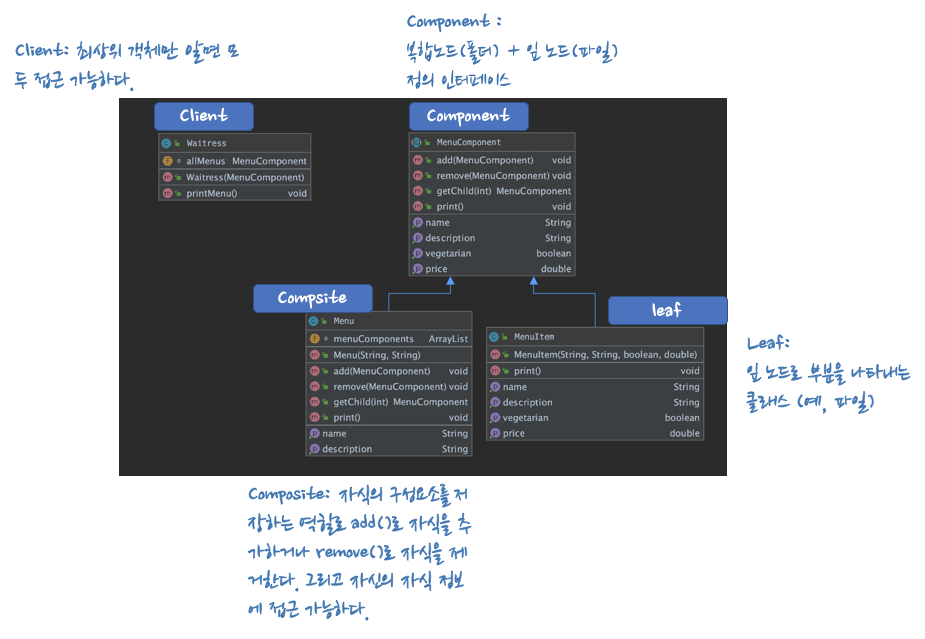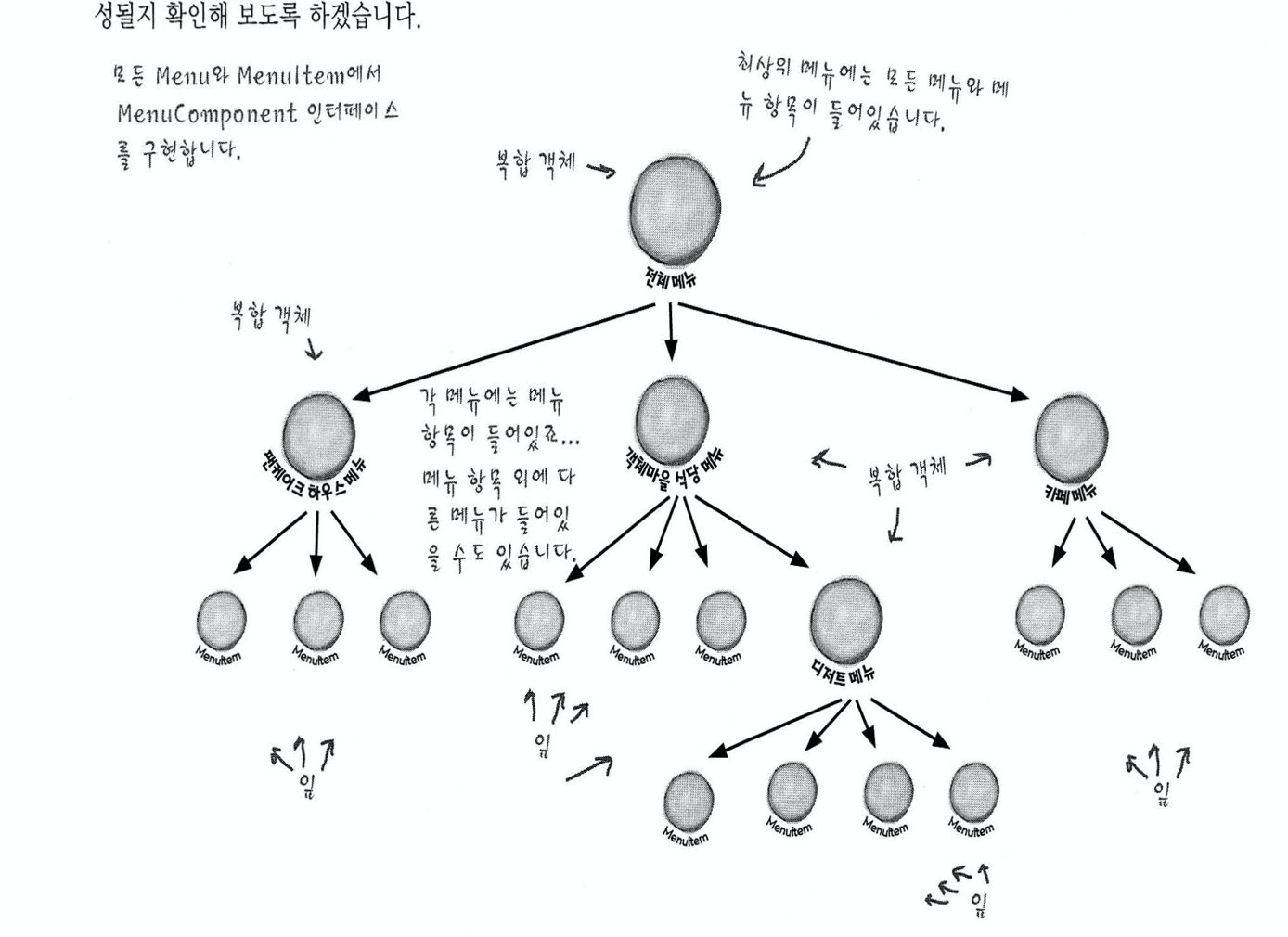👀 학습 목표
- 컴포지트 패턴을 이해한다.
- 컴포지트 패턴 예제를 이해한다.
1. 컴포지트 패턴 정의
1-1. 컴포지트 패턴이란
객체들을 트리 구조로 구성하여 부분과 전체를 나타내는 계층구조로 만들 수 있습니다. 이 패턴을 이용하면 클라이언트에서 개별 객체와 다른 객체들로 구성된 복합 객체를 똑같은 방법을 다룰 수 있습니다.
- 부분과 전체 계층구조: 폴더-파일, 디저트메뉴-초코케이크 등

2. 컴포지트 패턴 적용하기
2-1. 객체마을 식당에서 메뉴 안에 들어가는 서브메뉴를 만들어 달라고 한다…
디저트 메뉴가 있고, 그 아래에 서브메뉴를 넣고 싶다고 합니다. 기존에는 단순히 메뉴만 관리해서 넣어서 리팩토링이 필요해 졌습니다.

- MenuComponent
- Component로 복합노드(폴더) + 잎 노드(파일) 정의 인터페이스
// MenuComponent: Component로 복합노드(폴더) + 잎 노드(파일) 정의 인터페이스
public abstract class MenuComponent {
public void add(MenuComponent menuComponent){
throw new UnsupportedOperationException();
}
public void remove(MenuComponent menuComponent){
throw new UnsupportedOperationException();
}
public MenuComponent getChild(int i){
throw new UnsupportedOperationException();
}
public String getName(){
throw new UnsupportedOperationException();
}
public String getDescription(){
throw new UnsupportedOperationException();
}
public double getPrice(){
throw new UnsupportedOperationException();
}
public boolean isVegetarian() {
throw new UnsupportedOperationException();
}
public void print() {
throw new UnsupportedOperationException();
}
}- Menu
- 복합 객체 클래스
import java.util.Iterator;
import java.util.ArrayList;
// Menu: 복합 객체 클래스
public class Menu extends MenuComponent {
ArrayList menuComponents = new ArrayList();
String name;
String description;
public Menu(String name, String description) {
this.name = name;
this.description = description;
}
public void add(MenuComponent menuComponent) {
menuComponents.add(menuComponent);
}
public void remove(MenuComponent menuComponent) {
menuComponents.remove(menuComponent);
}
public MenuComponent getChild(int i) {
return (MenuComponent)menuComponents.get(i);
}
public String getName() {
return name;
}
public String getDescription() {
return description;
}
public void print() {
System.out.print("\n" + getName());
System.out.println(", " + getDescription());
System.out.println("---------------------");
Iterator iterator = menuComponents.iterator(); // 서브메뉴들을 출력하기 위함
while (iterator.hasNext()) {
MenuComponent menuComponent =
(MenuComponent)iterator.next();
menuComponent.print();
}
}
}- MenuItem
- leaf 클래스로 예를들면, 파일에 해당
// MenuItem: leaf 클래스로 예를들면, 파일에 해당
public class MenuItem extends MenuComponent {
String name;
String description;
boolean vegetarian;
double price;
public MenuItem(String name,
String description,
boolean vegetarian,
double price)
{
this.name = name;
this.description = description;
this.vegetarian = vegetarian;
this.price = price;
}
public String getName() {
return name;
}
public String getDescription() {
return description;
}
public double getPrice() {
return price;
}
public boolean isVegetarian() {
return vegetarian;
}
public void print() {
System.out.print(" " + getName());
if (isVegetarian()) {
System.out.print("(v)");
}
System.out.println(", " + getPrice());
System.out.println(" -- " + getDescription());
}
}- Waitress
- 클라이언트로 MenuComponent를 사용
// Waitress: 클라이언트로 MenuComponent를 사용
public class Waitress {
MenuComponent allMenus;
public Waitress(MenuComponent allMenus) { // 최상위 메뉴만 전달 받음!!
this.allMenus = allMenus;
}
public void printMenu() {
allMenus.print();
}
}- MenuTestDrive
- 아래와 같은 구성으로 메뉴를 구성

head first design patterns 책 이미지 참고
package composite_basic;
public class MenuTestDrive {
public static void main(String[] args) {
// Menu는 복합 노드, MenuItem는 leaf 노드
// 1. 기본 메뉴 추가 : 팬케이크메뉴, 카페메뉴,
MenuComponent pancakeHouseMenu =
new Menu("팬케이크 하우스 메뉴", "아침 메뉴");
MenuComponent dinerMenu =
new Menu("객체마을 식당 메뉴", "점심 메뉴");
MenuComponent cafeMenu =
new Menu("카페 메뉴", "저녁 메뉴");
MenuComponent dessertMenu =
new Menu("디저트 메뉴 ", "디저트를 즐기세요!");
MenuComponent allMenus = new Menu("전체 메뉴", "전체 메뉴");
// 2. 복합 객체의 add를 이용하여 각 메뉴들을 추가
allMenus.add(pancakeHouseMenu);
allMenus.add(dinerMenu);
allMenus.add(cafeMenu);
// 2. 각 메뉴 항목을 추가
pancakeHouseMenu.add(new MenuItem(
"K&B's Pancake Breakfast",
"Pancakes with scrambled eggs, and toast",
true,
2.99));
pancakeHouseMenu.add(new MenuItem(
"Regular Pancake Breakfast",
"Pancakes with fried eggs, sausage",
false,
2.99));
pancakeHouseMenu.add(new MenuItem(
"Blueberry Pancakes",
"Pancakes made with fresh blueberries, and blueberry syrup",
true,
3.49));
pancakeHouseMenu.add(new MenuItem(
"Waffles",
"Waffles, with your choice of blueberries or strawberries",
true,
3.59));
dinerMenu.add(new MenuItem(
"Vegetarian BLT",
"(Fakin') Bacon with lettuce & tomato on whole wheat",
true,
2.99));
dinerMenu.add(new MenuItem(
"BLT",
"Bacon with lettuce & tomato on whole wheat",
false,
2.99));
dinerMenu.add(new MenuItem(
"Soup of the day",
"A bowl of the soup of the day, with a side of potato salad",
false,
3.29));
dinerMenu.add(new MenuItem(
"Hotdog",
"A hot dog, with saurkraut, relish, onions, topped with cheese",
false,
3.05));
dinerMenu.add(new MenuItem(
"Steamed Veggies and Brown Rice",
"Steamed vegetables over brown rice",
true,
3.99));
dinerMenu.add(new MenuItem(
"Pasta",
"Spaghetti with Marinara Sauce, and a slice of sourdough bread",
true,
3.89));
dinerMenu.add(dessertMenu);
dessertMenu.add(new MenuItem(
"Apple Pie",
"Apple pie with a flakey crust, topped with vanilla icecream",
true,
1.59));
dessertMenu.add(new MenuItem(
"Cheesecake",
"Creamy New York cheesecake, with a chocolate graham crust",
true,
1.99));
dessertMenu.add(new MenuItem(
"Sorbet",
"A scoop of raspberry and a scoop of lime",
true,
1.89));
// 웨이터에게 최상위 메뉴를 전달
Waitress waitress = new Waitress(allMenus);
// 웨이터가 모든 메뉴를 출력
waitress.printMenu();
}
}2-2. 두가지 역할을 하는 MenuComponent
원래 한 클래스에서 한 역할만 맡아야 한다. 그런데 컴포지트 패턴에서는 단일 역할 원칙을 깨고, 대신에 투명성을 확보하기 위한 패턴이다.
- MenuComponent은 복합 노드, 잎 노드의 역할 모두 한다.
- 투명성: 클라이언트가 복합 객체와 잎 노드를 똑같은 방식으로 처리할 수 있도록 하는 것이다.
참고
- Head first design patterns 책